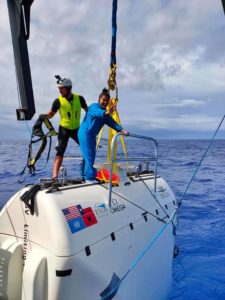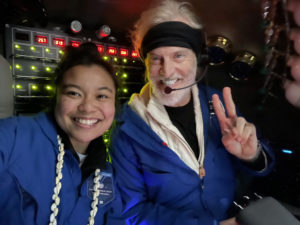Nicole Yamase: Honoring Her Culture through Science
 Nicole Yamase stands in front of the DSSV Pressure Drop, the 224-ft. research vessel taken to the Mariana Trench. She is wearing her local Pohnpeian skirt called 'urohs', head lei called 'mwaramwar', and is holding the Federated States of Micronesia flag. (photo by Jaya Roperez)
Nicole Yamase stands in front of the DSSV Pressure Drop, the 224-ft. research vessel taken to the Mariana Trench. She is wearing her local Pohnpeian skirt called 'urohs', head lei called 'mwaramwar', and is holding the Federated States of Micronesia flag. (photo by Jaya Roperez) “I just want young Pacific Islanders to see that there is no limit to what we can accomplish. I want them to see themselves in me. We can do anything!”
At only twenty-nine years old, Nicole Yamase, a PhD candidate in the University of Hawai’i at Mānoa’s Marine Biology Graduate Program, has made history. On March 11, 2021, Yamase became the first Pacific Islander to voyage to the Challenger Deep, the deepest known part of the Pacific Ocean’s Mariana Trench. On top of being the first Pacific Islander, she’s also the fourth woman, the first marine botanist, and the second-youngest person to ever make the trip. Fewer people have visited the Challenger Deep than those who have gone to the moon: only twenty-two people have made the trip, with Yamase being the twentieth.
There’s no doubt that Nicole Yamase is an inspirational role model for young Pacific Islanders interested in pursuing STEM, but she’s also an incredibly humble individual who shares her accomplishments with her community. Her connection to her heritage gives her a unique perspective in her research, and life in general.
Yamase was born in Pohnpei, but due to her father’s job, her family moved around often within the Micronesia region–from Pohnpei to Palau, then Saipan, back to Pohnpei, and finally to Chuuk, where Yamase ended up going to high school. Living in the Pacific, she notes that her childhood was filled with memories of the ocean. “We were always surrounded by water,” she told me, “We’d go snorkeling with my dad and he’d point out the coral, fish, and algae. My dream to go into marine biology stems from those experiences.” She currently studies the effects of climate change on macroalgae and nearshore marine plants.
She was raised Catholic, but her father always advised her to “just do good in the world and happiness will follow.” It is a philosophy she follows to this day. “Take care of yourself, your family, others, and the world.” Yamase is always considering how the community depends on the nature around us and her cultural background plays an important role in her work as a scientist. “When we go into the field, we always show respect and acknowledge our ancestors because these are the very lands and waters that they lived on.”
Pacific Islanders are culturally very communal, which helps drive Yamase’s passion to mitigate the effects of climate change. “If we want to move forward and tackle all of these environmental issues, we must work together, which is what our people have always done.”
The trip to the Challenger Deep

Nicole Yamase makes her way to the entrance of the Limiting Factor on the morning of the dive. (photo by Joselito Dela Cruz Membrot)
Yamase traveled to the Challenger Deep alongside Victor Vescovo, a well-known deep-ocean explorer and multi-world record holder. She was nominated by the Micronesia Conservation Trust (MCT), in partnership with the Waitt Institute, to represent the Federated States of Micronesia (FSM).
She traveled to Guam, to meet up with Vescovo and his team, where they then embarked on the 20-hour trip to the Mariana Trench. Vescovo owns the DSSV Pressure Drop, a support ship that is used to transport the DSV Limiting Factor, which is the only commercially certified submersible capable of reaching the full depths multiple times times. On March 11th, Vescovo and Yamase squeezed into the Limiting Factor and made the descent into the Challenger Deep. They spent 4 hours on the descent, explored the bottom for 2 hours, and then spent another 4 hours coming back to the surface, making it a 10-hour trip in all.
The most memorable part of the experience for Yamase was the moment they reached the bottom of the Challenger Deep. “This was the moment I was preparing for and waiting for, and here we are,” she recounts, “There was so much going through my mind.” As she looked out the small window of the submersible, Yamase was amazed at how untouched and undisturbed everything was, noting that it basically “looked like a desert, but underwater.” However, the moment was also tinged with a feeling of disappointment and urgency. “We did see plastic fishing lines at the bottom, and I was so shocked. I’m trying to bring awareness to that and how it’s such a shame, on our behalf, that there is trash in the deepest part of our earth.” This discovery continues to fuel her research and work in climate change, hoping to mitigate the far-reaching effects of our wastefulness.
During their trip down, Yamase couldn’t help but ask Vescovo why he started looking for someone from the FSM to join him on his 12th trip down. “He told me ‘It’s time for someone from the FSM to come down because it’s right in their backyard,’” referencing the fact that the Challenger Deep lies within the territorial waters of the FSM. Getting to represent the FSM made the trip even more meaningful for Yamase and, in preparation for the trip, she tried to focus on how to best do so for her community. “I wanted everyone to feel like they were coming down with me. It’s not just my accomplishment, it’s our accomplishment.”

Nicole Yamase and Victor Vescovo pose for a selfie at the bottom of the Challenger Deep, a depth of 10,925 meters. (photo by Nicole Yamase)
While onboard the research vessel, Yamase wore her local Pohnpeian urohs (skirts), mwaramwar (traditional head garland), and cowry shell necklace and also carried a small model canoe from her father, exemplifying multiple aspects of her heritage. The items represent her father, the first person to inspire her to go into marine biology, as well as her Micronesian heritage. The canoe also epitomizes Papa Mau Piailug, who was a key player in bringing back traditional navigation to Hawaiʻi, the Pacific Islands, and the rest of the world. “The canoe represented him and the knowledge and power of our ancestors and what they knew about our oceans, like how to sail with no advanced equipment. So, that canoe represented everyone: family, community, and ancestors.”
A bright future ahead
Yamase hopes that her story will inspire others, especially within the Pacific Islander community. There are very few Pacific Islanders pursuing careers in STEM, especially women, which is something she hopes will change in the near future. “There are a lot of students who want to do marine biology but it’s a fear of failing that stops them, which is unfortunate because we’re the best people to do this kind of fieldwork! There’s no other group of people who can study the ocean better than us.” Everything that Yamase does, she says she does for her islands. She wants to get more of the Pacific Islander community involved and to appreciate what their ancestors have left. “We need to take care of our natural resources for future generations. I hope we can leave this place better than when we came.”

The canoe Yamase brought down on the dive to represent her family, cultural heritage, and ancestors. (photo by Nicole Yamase)
She acknowledges that a lot of the barriers to STEM could be solved with more Pacific Islander leadership in science and academia and hopes she can help to fill those gaps in the coming years. Her long-term goal is to make her way back to Pohnpei and start a marine lab, where she plans to “build an army of local scientists.” Yamase recognizes that a lot of students don’t have the opportunity to travel or be exposed to summer internships, so she hopes to bring those experiences back to the FSM and provide fieldwork opportunities to aspiring young scientists.
As we look back at Asian American and Pacific Islander Heritage Month, it’s necessary to reflect on the tumultuous past that both groups have had in this country, yet it’s equally important to celebrate and acknowledge the amazing successes and future ahead. We must uplift the voices of future leaders and role models, like Yamase, who are furthering and developing evidence-based solutions to better our planet.
